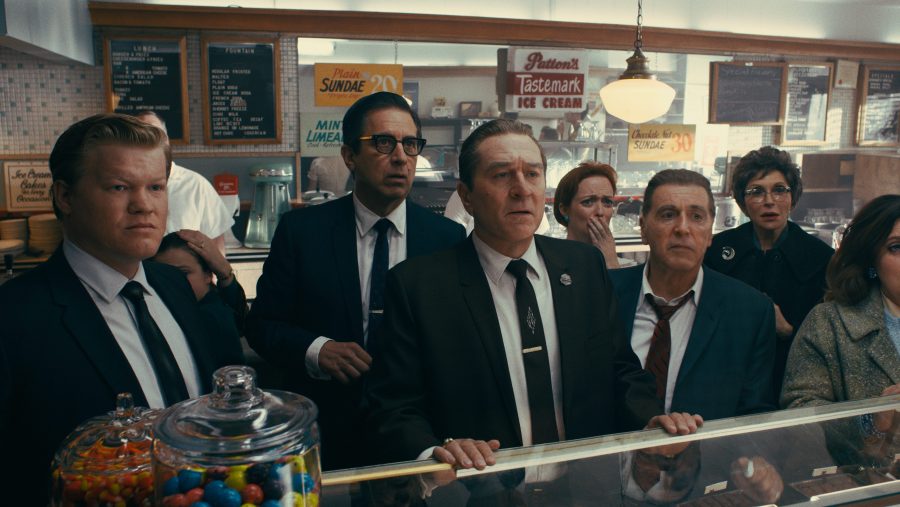Disclaimer: This review contains storyline spoilers. Proceed with caution.
Martin Scorsese has been unfairly pigeonholed as the man behind most of the mobster movie mythos from the ’90s onward. Despite films like “Age of Innocence,” “Silence” and countless others that have dealt with complicated religious and moral themes, people seem to be stuck with the idea that hyper-masculine mob movies are his only significant contribution to cinema.
In “The Irishman,” he seems to understand this, and leans into deconstructing the tough guy mafioso that some believe he glorifies.
The film is based on “I Heard You Paint Houses” by Charles Brandt, a nonfictional narrative, telling the possibly true story of mob hitman Frank Sheeran working with Russell Bufalino, and eventually killing Jimmy Hoffa. After years in development hell and extensive use of new computer-generated technology used to de-age Robert De Niro, Joe Pesci and Al Pacino, it’s finally here. It’s also three and a half hours long.
The runtime gives Scorsese room to just let the three screen legends act. Robert De Niro, as Frank Sheeran, is a blank slate, an empty vessel ready to take orders and kill whoever necessary. There isn’t much room for a showy performance until the last half hour when he becomes a broken old man with nothing left. Al Pacino brings the old-school fire as Jimmy Hoffa, a man with rigid beliefs and constant rants about the Kennedys being out to get him.
The real revelation is Joe Pesci as Russell Bufalino, completely playing against the type of his previous Scorsese-directed outings. Those characters seethed with a barely-controlled rage, while here, he gives a quiet and understated performance. He says more with just a look and a nod than the script even gives him.
“It is what it is” becomes a terrifying phrase as he whispers it and calmly condemns people to death without blinking an eye. It’s also simply exciting to see him on screen again and a shock that he has shied away from acting, while still carrying such scene-stealing talent.
The great acting allows Scorsese to do as he pleases, directing the movie in a calm and collected manner, reflecting the coldness of the characters. Occasionally the camera goes for a showy movement and glides over a city or dramatically zooms in on a face. And yet, it never distracts and instead sits still in full view of the action.
The dark dinner lights of an Italian restaurant or the red neon signs of a bar remind you who’s running the show. It’s all so comfortable and familiar for those who have seen Scorsese’s work. There are still Thelma Schoonmaker’s, Scorsese’s longtime collaborator and editor, fingerprints all over, as music queues perfectly sync with movement on-screen. Even these moments are low-key, as there is none of the fast-paced, frenetic editing that made “Goodfellas” or “Wolf of Wall Street” zip by. Every scene simmers in the slow fate that awaits all of these characters.
“Would you like to be a part of this history?” Hoffa asks Sheeran over the phone in their first interaction. The weight of history hangs over “The Irishman.” The relevancy of real-life union leader Jimmy Hoffa’s disappearance from national news is eventually just a faded photograph. The memories fade, and so do the violent men who hold them.
Characters based on real mafiosos get introduced with a title card that states how they died. This is a fast life they were all living. These are men that have only learned to move upward in the world through violence. It tears at the fabric of their family lives and leaves a hollow, pitiful existence.
If you’re familiar with the story of Jimmy Hoffa at all, you know how the story most likely ends. It’s everything that comes afterward that is nothing like anything Martin Scorsese has put on screen before. The last act is a sad examination of the damage this life causes as these characters age. It twists the typical mafia story into one of broken familial connections.
A Christmas, alone and old, is played as more devastating than dying young. A wheelchair-bound Sheeran looks at a mausoleum and sees it as a less frightening end without the finality of a grave or a cremation because the building remains in view of others.
This film is Scorsese’s mausoleum to the gangster genre. Sure, he already has more movies in the works, but it’s doubtful he’ll ever make another mob film starring these three greats.
With “The Irishman,” Martin Scorsese has defined his career on his terms. The runtime makes this film not for everyone, but if you have already loved his previous work, then you’ll cherish this last ride. “It is what it is.”


